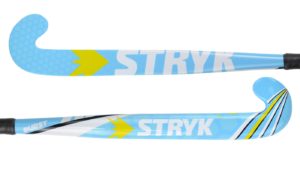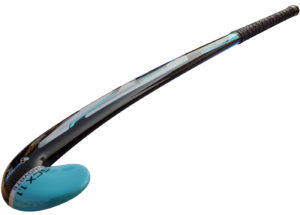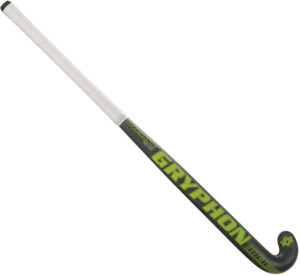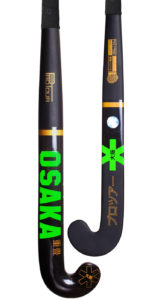Which field hockey stick is best for my position and/or skill level?
With the vast amount of options these days, it can be difficult to choose which field hockey stick to purchase based on your position and skills. Here we break down which sticks are best for each position or skill level and why, and we’ve included our stick recommendations for you to check out.
Beginners
It is recommended that a beginner player use a stick with a standard bow shape and no larger than 20 millimeters in size.
Beginner field hockey players should choose a stick with a wood or fiberglass composition. Wood sticks will provide the most forgiving feel and the best touch on the ball, while fiberglass sticks also provide an excellent first touch with a lightweight feel. Having a flexible stick will help them learn the fundamentals, so they can get accustomed to trapping the ball without too much rebound off the stick. It should feature a larger hitting surface to help players get a touch on the ball. A maxi toe or hook head shape will offer you the largest surface area, ensuring you make great contact with the ball when trapping it or driving it down the field.

When choosing a stick, you must also consider the bow size and shape. It is recommended that a beginner player use a stick with a standard bow shape and no larger than 20 millimeters in size. This will help him or her learn the basics while maintaining excellent control over the ball. A larger size or later shape will more easily cause the ball to pop up in the air and earn yourself a dangerous play whistle. A standard bow is very versatile and can be used on offense or defense, making it the ideal stick shape for beginners who have yet to discover which will be the best position for them.
Our recommendations:
and
Defenders
We recommend buying a stick that has a higher fiberglass content since carbon can be more brittle in a compound stress way.
When searching for the perfect stick, defenders will often choose heavier sticks with the weight concentrated in the head of the stick. This allows them to make stronger block tackles, and the extra weight will help generate more momentum when hitting the ball down the field. Also, often times, defenders will buy slightly longer sticks than their player height recommends to give them a little extra reach when tackling and jabbing at the ball.
 Since defenders see a lot of stick-on-stick contact when tackling their opponent, they require a stick with a lot of durability. We recommend buying a stick that has a higher fiberglass content since carbon can be more brittle in a compound stress way. Including aramid in the composition can also help improve the strength and durability of the stick, and it dampens the vibrations felt in the handle of the stick for less sting in your hands. In addition, we recommend choosing a stick with a maxi toe as it provides the largest sweet spot, allowing you to make better contact with the ball when hitting or trapping it.
Since defenders see a lot of stick-on-stick contact when tackling their opponent, they require a stick with a lot of durability. We recommend buying a stick that has a higher fiberglass content since carbon can be more brittle in a compound stress way. Including aramid in the composition can also help improve the strength and durability of the stick, and it dampens the vibrations felt in the handle of the stick for less sting in your hands. In addition, we recommend choosing a stick with a maxi toe as it provides the largest sweet spot, allowing you to make better contact with the ball when hitting or trapping it.Our recommendations:
STX Apex 901 Field Hockey Stick or other sticks in the STX Apex line
and
Midfielders
The attribute we find most important in a midfielder’s stick is control. Midfielders are responsible for controlling the ball and delivering it safely to the attackers to put it in the back of the net. They are also sometimes trying to score themselves, or they are trying to stop their opponent from advancing down the field. Therefore, a lightweight and well-balanced stick with a lot of versatility is a must.
The presence of aramid in a stick’s composition can make all the difference. Aramid dampens vibrations to keep the ball from rebounding too far off the stick, allowing you to have great control when trapping the ball and dribbling. It also adds durability to the stick, helping to prolong its life even with all the stick-on-stick contact it sees when making defensive blocks and tackles.
 Since midfielders play with the defense and the offense, they need a lightweight stick that can keep up with the speed of their game and offer the necessary precision for ball handling and passing skills. A midi toe provides a well-balanced feel that’s great for all around stick skills, especially reverse stick work, and it provides a decent sized sweet spot for quickly trapping the ball and passing to your teammate. A standard or mid bow size (19 – 23mm) is recommended for midfielders because of its versatility, but any shape you are most comfortable with can be used.
Since midfielders play with the defense and the offense, they need a lightweight stick that can keep up with the speed of their game and offer the necessary precision for ball handling and passing skills. A midi toe provides a well-balanced feel that’s great for all around stick skills, especially reverse stick work, and it provides a decent sized sweet spot for quickly trapping the ball and passing to your teammate. A standard or mid bow size (19 – 23mm) is recommended for midfielders because of its versatility, but any shape you are most comfortable with can be used.Our recommendations:
and
Forwards
Offensive players, or forwards, prefer to use lightweight sticks that are well-balanced, giving them the necessary agility to move the ball around their opponent. A lightweight stick is not only more effective when dribbling, but it allows you to swing your stick faster and quickly get a shot off before the defender can intercept it. A midi toe also helps to enhance a forward’s abilities. The toe is smaller in size and lighter in weight, and it increases maneuverability and offers more precise ball control. It allows you to quickly and easily move the ball from side to side to dodge your opponent and dribble towards the goal.
 A forward demands power from his or her stick. They must be able to generate extreme power when shooting and when passing to an open teammate across the field, which is why they need sticks with a high carbon content. The higher the carbon content the more powerful the stick will be and the harder it will be for your opponent to stop you. This added power will also improve your drag flicks and aerial skills to enhance your 3D game. The attacking position is defined by speed, accuracy, and precision, so their sticks should be too.
A forward demands power from his or her stick. They must be able to generate extreme power when shooting and when passing to an open teammate across the field, which is why they need sticks with a high carbon content. The higher the carbon content the more powerful the stick will be and the harder it will be for your opponent to stop you. This added power will also improve your drag flicks and aerial skills to enhance your 3D game. The attacking position is defined by speed, accuracy, and precision, so their sticks should be too.Our recommendation:
Aerial players
The most important element of a stick that the aerial player should consider is the shape and size of the bow. A stick that bends closer to the head will allow you to get under the ball more to perform aerials and lifts. A low bow or late bow is most recommended since their point of maximum bow is the closest to the head the FIH will allow (200mm). Also, the more the stick bends the easier it will be to execute 3D skills with precision and accuracy. A large bow, such as a 24 or 25 millimeter, will help generate high velocities when drag flicking.
Another feature that has recently become more popular is incorporating a slight concave channel onto the face and shaft of the stick. This helps to channel the ball where you want it and keep the ball on your stick as you lift it up for aerials.
Our recommendations:
If you’re uncertain which position you will be playing when purchasing your stick, it would be best to buy a medium-weight stick that’s versatile and can be used in any position.

